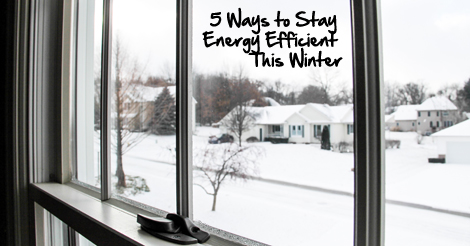Despite the recent unseasonably warm weather, the blustery, cold winter weather is nevertheless bearing down on us. Before you know it, you’ll be faced with higher utility bills as your heating system works to keep your home cozy and warm. Want to spend less to heat your home this winter? Save some green with our top five winter energy-efficiency tips!
- Look for leaks: One of the best home energy-efficiency tips we can offer is to inspect your home for gaps and cracks. By reducing drafty spots in your home and plugging air leaks, you can increase your home’s energy efficiency and save up to 20% on your energy bills. Though this is best done by a professional, you can check for leaks on your own by conducting a visual inspection of the interior and exterior areas of your home. Outside, you’ll want to look for gaps at corners, where brick and siding meet, and around outdoor faucets and chimneys. Inside, inspect the areas around outlets, switch plates, door and window frames, baseboards, vents, fans, and attic hatches. If the air outside your home is significantly colder than the air inside, you may be able to feel cold spots in areas that require attention.
- Deal with drafts: once you’ve identified the source(s) of air leaks, it’s time to fix them. Applying weatherstripping around doors and windows can help, as can caulking with spray foam or silicone in the gaps and cracks around stationary components, such as fixtures. However, in order to maximize energy efficiency—and experience the most dramatic reduction in your home’s energy costs—it’s often best to replace your windows and doors. That’s because these are two areas of your home through which your money can literally go out the window (or door). Window and door technologies and installation processes continue to improve by leaps and bounds, meaning that even if your windows and doors are just ten years old, your home (and your wallet) would almost certainly benefit from the installation of new, energy-efficient models.
- Head upstairs: Energy.gov, which offers a variety of home energy-efficiency tips, says that heat loss through the ceiling and walls in your home could be very large if the insulation levels are less than the recommended minimum.” Unfortunately, home builders often install the minimum recommended amount of installation, so the level of insulation in your home is likely inadequate, especially if you have an older home. Check for cracks and gaps up in the attic just like you did in the rest of the home. When sealing leaks, be sure you’re not covering up any vents. Then add insulation to the attic ceiling and floor. Thinking of replacing your roof? If it’s more than 15 years old, it makes sense to replace your roof and have insulation added at that time. Not only will you reap the benefits of the adding batting and spray foam, you’ll also have a more energy-efficient roof. New roofing technologies mean today’s roofs reflect excess heat and seal out cold and wind better than ever before.
- Get checked out: Before that cold weather blows in, be sure to get your heating system inspected and cleaned. Replace filters if appropriate, and check all duct work for cracks or wear. Got a unit that’s more than 15 years old? Consider swapping it out for a newer, more energy-efficient model.
- Light for less: One of the best home energy-efficiency tips is also the easiest to execute. Swap out your incandescent bulbs for CFLs or LEDs and consider using timers, sensors, or dimmers to further control and reduce your lighting costs. (Training the kids to shut off lights when they leave a room helps, too!) Other winter energy-efficiency tips that can be put to good use any time of year include shutting off and unplugging electronics and appliances when they aren’t in use and/or purchasing new, more energy-efficient products.
While it’s true that there is often a significant upfront cost with some energy-efficient upgrades, there are also big benefits. If you make energy-saving investments, including new windows, doors, roofing, or heating systems, you may be eligible to receive federal income tax credits. You’ll also save money over time by spending less to heat (and cool) your home, as well as increase the value of your property and improve its curb appeal. Once you’ve carried out our winter energy-efficiency tips, you can settle back in your warm, cozy home and enjoy the cost savings you’re sure to enjoy this winter. Wondering whether your home would benefit from new roof or new windows and doors? Give us a call at 973-927-0963 today and one of our experts will come to your home, review your options, and provide you with a free, no-obligation estimate!
